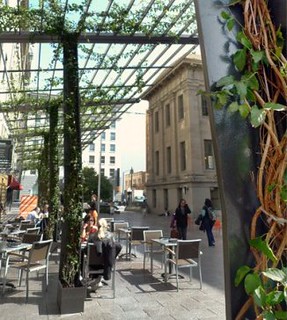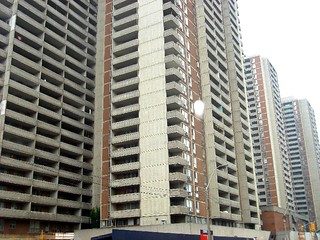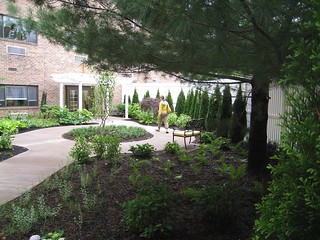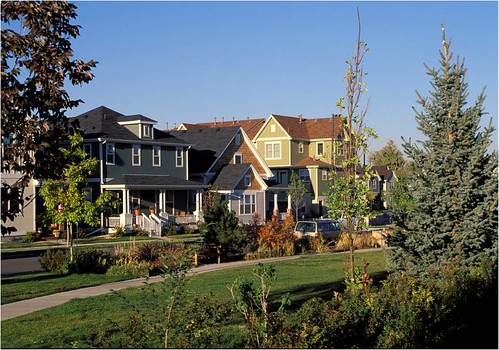Smart growth is a start. But it's not enough.

Posted April 24, 2012 at 1:29PM
I want to follow up on yesterday's article about placemaking. Reacting to an excellent essay by Ethan Kent, I posited that that the creation and strengthening of great places - great people habitat, if you will - should be a very important part of a “new environmentalism." Indeed, I wrote that to a great extent it already is, having been taking hold at least since sometime in the 1990s. Today, I would like to take that point further and argue that great placemaking should also become a very important part of, or even a possible successor to, what we have been calling "smart growth." I don't think that it is currently an important part of the smart growth agenda, unfortunately, or that it is to nearly the degree that it should be.
I was lucky enough to be there at the beginning, when we first started using the phrase "smart growth" to describe an alternative to suburban sprawl, a better way of accommodating a growing population and economy with less damage to the environment. It did indeed represent, in a way, part of the "new environmentalism" I discussed yesterday, in that it was affirmative, a philosophy not opposed to development, but of making it better.
Most readers probably know the smart growth fundamentals: by building homes, shops and services on vacant and underutilized land left in our older communities by decades of disinvestment, and by building in more compact development patterns with more efficient transportation links,  we can reduce the spread of environmental harm and growth in emissions while conserving valuable wilderness and rural land outside of the development footprint. More than anything else, smart growth was - and remains - about a more deliberate and sensible allocation of land and development.
we can reduce the spread of environmental harm and growth in emissions while conserving valuable wilderness and rural land outside of the development footprint. More than anything else, smart growth was - and remains - about a more deliberate and sensible allocation of land and development.
We now have oodles of research quantifying the benefits of smart growth to the environment. If we build this way, we will reduce carbon emissions, air pollution, land consumption, and water runoff compared to a continuation of the sprawl paradigm that shaped our landscape in the last half of the 20th century. We have to do this.
And yet. Something has been nagging me about smart growth for years. I believe that, at least for those of us in the policy world, the smart growth agenda has become a bit formulaic and even clinical: we tell ourselves and others, for example, that we must increase settlement density, which we measure in dwelling units per acre or the ratio of building floor space to lot space; that we must reduce driving, which we measure by vehicle miles traveled; that we must reduce carbon emissions, which we measure by metric tons. And so on. If we're looking at a growth scenario, we may measure these things on a per capita basis.
We judge potential policy measures by how well they will produce these outcomes. When a new government action allows us to project out the numbers favorably, we rightfully applaud it. Often I'll be among the cheerleaders.
But, as I have opined before, the fact that we are increasing dwelling units per acre, reducing vehicle miles traveled per capita, and reducing tons of carbon emissions compared to sprawl does not mean that we are making great people habitat. We may be creating smart growth, while in some cases doing little for people or doing less for the natural environment than we could be. I believe that achieving the fact of smart growth, where we have it, is no longer enough, and may not warrant our enthusiasm as much as it did, say, a decade ago. It is time to focus more on the quality of what we are building.
 To an extent, we have become slaves to measurable outcomes. In the nonprofit world, our sources of funding demand it. Increasingly, so do our managers and never-ending strategic planning exercises. (I am sooooo tempted to go into a detailed rant here but, really, this isn’t the place.)
To an extent, we have become slaves to measurable outcomes. In the nonprofit world, our sources of funding demand it. Increasingly, so do our managers and never-ending strategic planning exercises. (I am sooooo tempted to go into a detailed rant here but, really, this isn’t the place.)
But what if we produce urban density that saves land and reduces carbon emissions, but overwhelms people with its scale, looks mediocre and, by the way, creates hotspots of environmental impacts? Should we still be applauding? Because, to my eye, that is exactly what has happened in some places.
I’ve been beating a drum on this cause for a while now. I’ve argued that so-called smart growth shouldn’t be considered smart if it doesn’t include green buildings and green infrastructure, if it doesn’t show respect to our historic buildings and local culture, if it doesn’t foster public health, if it isn’t equitable. And these are just the more familiar topics. My colleagues in the smart growth world don’t disagree with me about these things, but after they nod their heads in a meeting they go right back to work on urban density and transportation issues, because they must to fulfill obligations.
For a long while I thought the right tack was to reform smart growth from within, adding the concerns (such as green infrastructure and food) that weren’t at the forefront when the movement was founded. Some leaders in our field are, in fact, convening a process to that end. There have been a couple of preliminary meetings. Maybe something good will come of this.
But my nagging feeling won’t go away. Even if we add some neglected categories and tweak some others, we’re still stuck in a box that makes it all about defined issues and, to a great extent, measurable outcomes. We remain fixated on things that can be accomplished through broad policy initiatives.  That remains vitally important, but I don’t think it’s enough.
That remains vitally important, but I don’t think it’s enough.
I’ve now come to the conclusion that smart growth is critical to a sustainable future, but it can only get us part way there. The truth is that much of what can make people habitat great cannot be quantified or put into identifiable categories. The process of creating a better, more sustainable world – anchored by better, more sustainable places - is as much art as science.
Our communities of the future must not only reduce carbon emissions, save land, and encourage use of transit, walking and bicycling. They must also contain beauty, warmth, places of solitude and reflection. They must be significantly more dense than sprawl, but also sometimes forego additional increments of density in order to maintain light, limit noise, provide privacy, and respect a human scale. They must be conducive to engaging the intellect and the spirit. When we pursue these things, we are out of the realm of smart growth per se, and into the realm of placemaking. I have become convinced that the two overlap but should not be mistaken for the same thing. In other words, sustainability in our built environment requires both smart growth and great placemaking.
If that’s too mushy for you, I’ll give you a more strategic reason. Those of us who are advocates of smart growth – and I’ve been one for going on twenty years – often make our case with numbers: amounts of pollution avoided, dollars saved in infrastructure expenses, acres of land conserved, and so on. Our opponents don’t do that, at least not much (in part because the numbers are not on their side). They appeal to emotion: do you really want, they ask the public, to live in or amidst tall buildings? Don’t you want a big yard for your kids or dog? Don't you want to keep the freedom that your car gives you? Those are not unreasonable questions.
 If our preferences don’t include not just good places but great ones, beautiful ones, lovable ones - places that provide what people seek but in a setting that is more sustainable - we lose in that set of arguments. People are naturally resistant to change and must be inspired in order to embrace it.
If our preferences don’t include not just good places but great ones, beautiful ones, lovable ones - places that provide what people seek but in a setting that is more sustainable - we lose in that set of arguments. People are naturally resistant to change and must be inspired in order to embrace it.
I don't think smart growth by itself gets us there. We need to stop thinking of smart growth as a goal but instead as a tool to achieving the more demanding goal of creating better, greener, more sustainable people habitat. If we want to win hearts as well as minds, we need to start paying much more attention to placemaking, to the quality of what we advocate. In fact, I would go further. If we want to deserve to win, we need to pay a lot more attention to making great places. It's not just about the numbers: to paraphrase Gil Scott-Heron, the revolution will not be quantified.
Related posts:
- Sustainable places: where the healing can begin (November 3, 2010)
- Addressing the environmental paradox of smart growth: a gallery of green density (April 12, 2010)
- The environmental paradox of smart growth (April 9, 2010)
- In sustainable communities, architecture, and preservation, does beauty matter? Should it? (February 24, 2009)
- An open letter to the smart growth community (October 22, 2008)
Move your cursor over the images for credit information.
